No Filter
for the Right
for the Right
How Right-Wing recruiters
use Instagram to attract
young people
Propaganda, Networking and Recruiting
How Thousands of Right-Wing Accounts Exploit Instagram’s Vulnerabilities
It looks like a typical Instagram post: A blonde baby, wrapped in a soft, light brown shawl, sleeps peacefully in a cradle. The child is surrounded by a small plush wolf, a wooden sword, and some decorations. Warm lighting contributes perfectly to the mood. In short: pure innocence.
More than 600 users ‘like’ the post.
But just one look at the comments below reveals that the image means something quite different: The baby is a “fighter”, one user wrote. In a few years, the child will be ready for the “spring offensives”.
Then, the symbol in the photo becomes clear: The wooden decoration placed next to the baby’s head is a Black Sun. Consisting of several overlayed swastikas, it is one of the most widely recognized symbols of modern right-wing extremisism. The symbol is reminiscent of a well-known SS ornament.
An infant next to a neo-Nazi motif? Welcome to the dark side of Instagram.
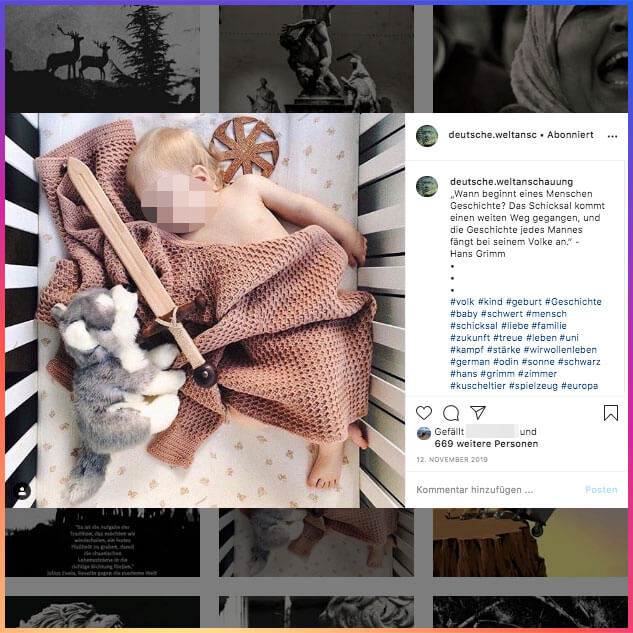
For most people, Instagram is a colorful and relatively harmless universe. Users post beautiful photos of nature, travel tips, recipes, or cute animals. It is a world in which models share their private lives, influencers advertise products, and artists present their work. Users can tag themselves in shared photos to show when they’re at a lake or out to eat.
Life looks good on Instagram – and that’s how Facebook, which has owned the platform since 2012, wants to keep it.
But there’s another world on Instagram — a world in which the motto is: “It’s great to be white.” A world in which thousands of right-wing and far-right extremist users nourish the belief that Germany and Europe are under attack. A world in which white women are advised not to “mix”.
The leading figures in the scene understand Instagram’s dynamics very well. They know how to camouflage themselves and how to take advantage of obvious weaknesses in the platform’s algorithm. They have developed strategies for attracting views through seemingly harmless images and hashtags – such as #heimatverliebt (roughly translated „love of homeland“) – allowing them to not only spread radical content, but also attract young supporters to their cause.
A Correctiv Analysis Shows, for the First Time, the Extent to Which Right-Wing Extremists Are Using Instagram to Network and Recruit Young People
For months, we followed the Right-Wing Instagram users from a fictional account, allowing us to learn about their world. We expanded our network by accepting the algorithm’s suggestions. And we collected a lot of data.
Our team consists of several reporters, a data journalist, and a scientist. In total, we analyzed roughly 4,500 Instagram accounts and created the first-ever map of the intricate network of German Right-Wing Instagram users. Our investigation reveals its key figures, how they communicate, and how they promote themselves and their ideology.
A former influencer for the far-right “Identitäre Bewegung” (Identitarian Movement, IB) told us how the organization actively recruits new members through the platform. “Women are used as showpieces,” she said. “Exploitation, until the point of no return.”
A board member of the “Junge Alternative” (Young Alternative) Berlin – the youth organization of the AfD – told us that the regional association now gets half of its recruits via Instagram. On his personal account, he showcases members of the JA and AfD, most of whom are women. Our investigation found that women in particular play a central role in the right-wing Instagram network. They can build a bridge between ostensibly apolitical aesthetics and a far-right worldview, ultimately connecting young users with right-extremist circles.
A former Instagram developer told us how difficult it is to escape the algorithm’s pull: It is designed to show people more and more of the same content. In this sense, Instagram – which is owned by Facebook – is no different than any other social media platform.
“Nobody at Facebook has looked at how German right-wing extremist accounts and symbols can be recognized or fought,” said the expert.
The company does not seem to look out for the Right’s subtle strategies. Although Instagram forbids the use of the Black Sun on its platform, the photo of the baby was only taken down after we reported it. A spokeswoman for Instagram said that it would be “helpful” if we could report more content of this kind in the future.
The Right is using women who are lifestyle bloggers and influencers to sell their ideology to young people on Instagram – and the platform has no antidote.
Instagram’s Multiplication Tables
In our analysis, the account of one photographer in particular kept appearing as a connection point: “germanyspride“. The first two years of posts show mostly landscape and architectural photography. But in September 2019, he began posting portraits of young and good-looking men and women. We found a common thread among most of the subjects: A connection to the JA or AfD.
The account looks like a glossy portfolio for the two organizations. It even features prominent figures within their ranks, such as Mary Khan, JA’s deputy federal chairwoman, and Marie-Thérèse Kaiser, the Rotenburg district chairwoman and campaign face for the AfD. Lisa Lehmann, who is on the board of the JA Saxony-Anhalt, also appears several times.
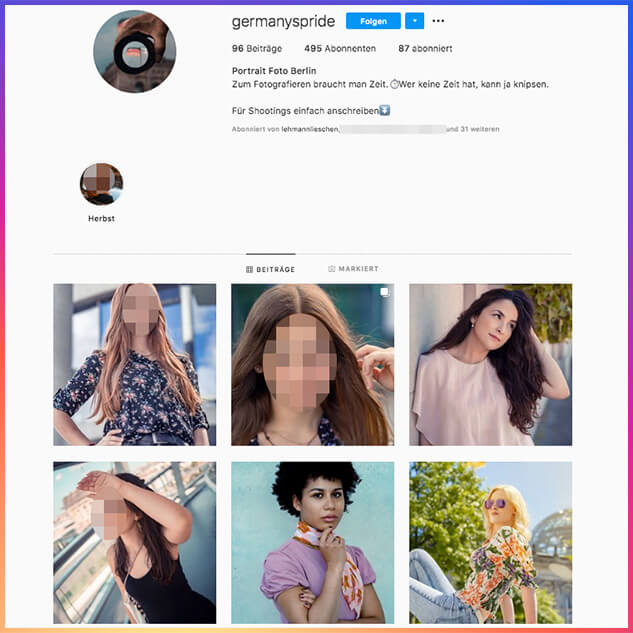
The photographer is Vadim Derksen, a member of JA’s federal board. In a conversation with CORRECTIV, he said that the “germanyspride” account is actually just a by-product. It goes back to September 2019, when he photographed a JA Berlin campaign titled “Nie wieder Sozialismus” (Never Again Socialism). “That was the initial spark,” said Derksen. The goal was to take pictures “where we don’t have a stuffy look, but rather the way young people normally look like.”
Junge Alternative has been focusing its efforts on Instagram for about a year, confirmed Vadim Derksen. Their intention is to appear “young, agile, attractive”. The fact that JA Berlin held a photography workshop in July 2019 fits with this statement. “We try are trying and becoming more professional,” wrote the regional association on its account.
Instagram is one of the most popular social media apps in the world. According to Facebook, more than 500 million users engage with Instagram daily. In Germany, almost 50 percent of 14 to 29-year-olds are daily users, according to a 2019 study by ARD and ZDF.
The JA seems to have recognized what is important on Instagram. “People want to see people, including positive people, and fewer organizations. It’s very clear,” explained Derksen. Every industry operates in a way such that “you don’t primarily have a product upfront, but people. And these people then deliver the message. That is the basics of Instagram. That’s exactly how we work, too, so that the people are in focus.”
Bringing Hashtags into Play
On Instagram, the women JA activists share insights into their everyday life. Political content may not be in the foreground, but it’s there subliminally. Take a photo of Lisa Lehmann having a beer after work, for example – or in the Harz mountains, or on the island of Sylt. She is constantly on the go, taking photos on behalf of JA Berlin. Lehmann often adds the hashtag #Heimatliebe to the posts on her public profile with around 1,500 followers. In her account biography, she does not state her political affiliation. There is only a quote in Frakturschrift, the official font of the Nazi party: “Ein Mensch, der keine Heimat hat, gleicht einem windverwehten Blatt.” (A person without a homeland is like a wind-blown sheet).
The JA does not use hashtags randomly. Instagram users use hashtags to find new accounts and content on a topic that interests them. The hashtag #Heimatliebe is a bit difficult because a lot of people use it, “but it fits in with us, purely thematically; that’s why we use it to fill this hashtag,” explains Vadim Derksen.
Heimatliebe, or love of the homeland, is clearly a main theme in JA’s Instagram presence. Some activists are rather clear about this. On her private profile, Hana K. – a board member of JA Berlin – regularly posts dreamy portraits of herself with captions such as: “May the last rays of sunshine of the year also be the last for Merkel in Government!”. And under a photo of her smiling with a colorful maple leaf: “A fall leaf is better than a burqa.” Hashtag #Heimatliebe (love of homeland), hashtag #patriotisch (patriotic).
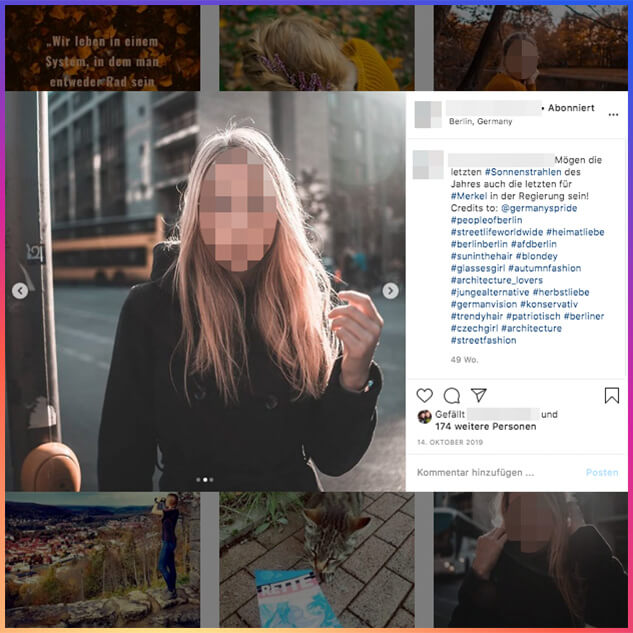
“We’re still at the very beginning,” said Derksen. “As intensively as we’re doing it now, it’s only been a year. But yes, there are successes.” About half of the membership growth of JA Berlin over the past year can be traced back to Instagram. The regional association has around 1,500 followers on platform. “The people who are interested come to us themselves. In other words: they write to us on Instagram.”
Our investigation reveals how political content is mixed with harmless hashtags. Searching for #heimatverliebt (love of homeland) on Instagram gives around 4,500 results immediately: colorful photos of nature, architecture, people in traditional costumes. Scrolling down shows a post with a photo of the German flag and the hashtag #Jungealternative. In another picture, a young man poses in front of a banner that reads “Volk” (people, in the sense of nation). It was posted by a right-wing extremist account called “Altstadtrevolte Bautzen” (Bautzen Old Town Revolt), which is closely related to the Identitäre Bewegung (Identitarian Movement, IB).
When asked about the use of the hashtags by different groups, Derksen wrote: “We have no control over who uses these hashtags and we also do not control this because it is totally absurd.”
Women as Links in the Network
Time and time again, the Instagram accounts of young women who are followed by many activists appeared as strong links within the Right-Wing network. During our investigation, it quickly became clear that we had to concentrate on these influencers.
“The right has long been aware that women appear to be more peaceful,” said Katrin Degen, a doctoral student at the University of Bamberg who is authoring a thesis titled “Gender and Sexuality in Social Media Discourses of the Extreme Right”. As early as the 1990s, women carried posters at demonstrations. The few women who were members of the NPD were specifically asked to get themselves elected to school boards. This tradition continues on social networks such as Instagram, explained Degen: Women are always “sent to the front” where it is necessary to introduce “ideology through the back door”.
To find out which of the 4,500 accounts in our database were particularly relevant, we first identified the profiles of roughly 130 women “influencers”. Then, we filtered them according to the strength of their connective function for the entire network of 4,500 accounts – leaving us with a total of 50 influencer accounts. Among them are prominent names such as Brittany Sellner, who is married to the head of IB Austria, Martin Sellner. She has more than 30,700 followers on Instagram. Among the AfD accounts, Marie-Thérèse Kaiser has the most followers – around 8,800.
Most of the influencers move within the IB network as well as a larger group of accounts we classified as “Right subculture”, such as fashion or music labels. We were most interested in the accounts that belonged to women members of the IB or JA – which often drew direct connections between the organizations.
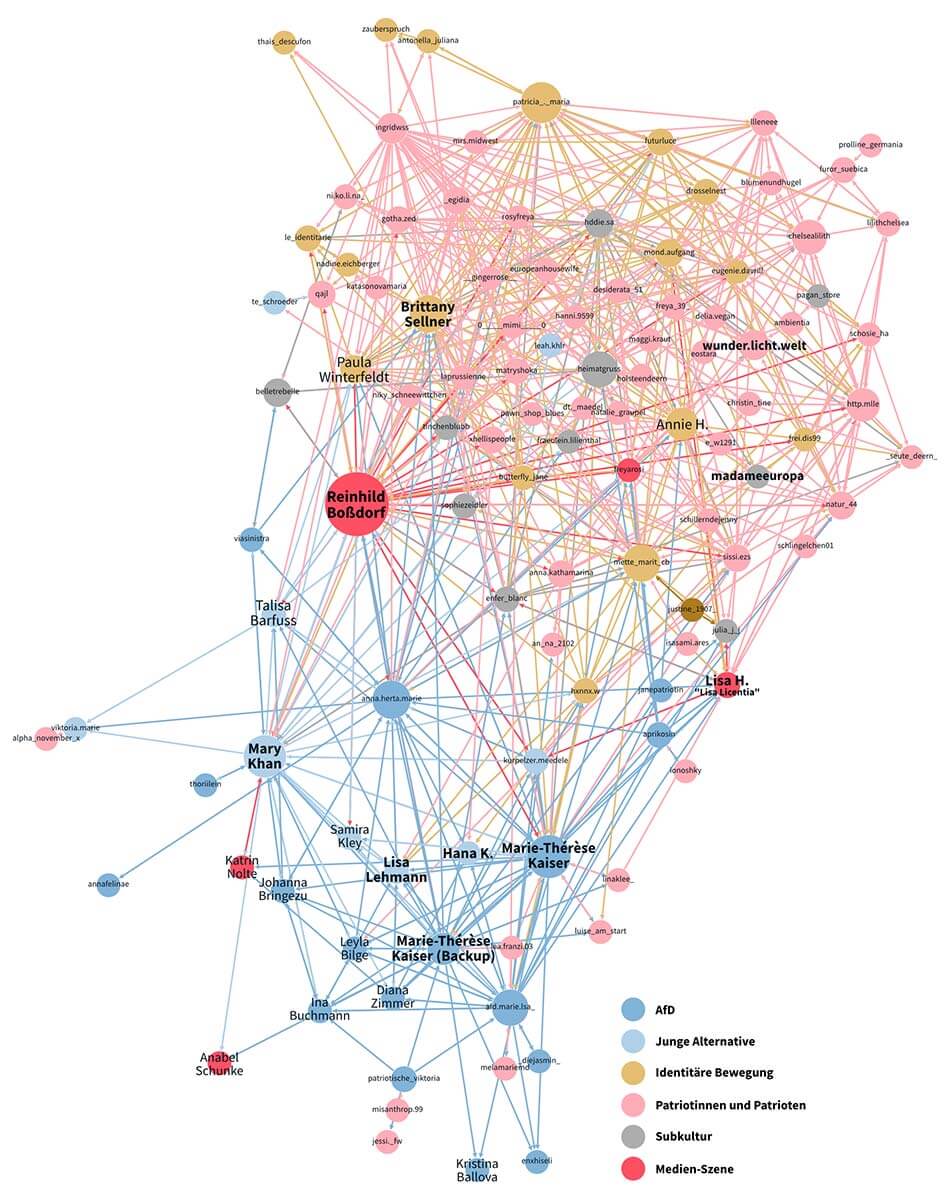
See the network in higher resolution
According to the Bundesamt für Verfassungsschutz (Domestic Intelligence Service of Germany ), IB Germany is a “confirmed right-wing extremist endeavor”. It represents a nationalist idea of a people that contradicts the Constitution. Similarly, JA has been classified by the Agency as a “suspected instance“ of an extremist organization and is therefore also being monitored.
On Instagram, the groups hide behind seemingly harmless content. The profiles of young women within their network blend in with thousands of other accounts on the platform.
Hardly any of them use their real names, and many do not openly show that they belong to groups such as IB. The largest group in our database has therefore been classified as “patriots and conspiracy ideologues”. It includes everyone who we could not clearly identify as affiliated with a particular organization, ranging from fans of the right-wing extremist rapper Chris Ares to those who simply posted about right-wing ideology.
Some of the signs are so subtle that even members of the right-wing network cannot always recognize kindred spirits at a first glance.
Insider: Instagram is Important to Feed the New Right Movement
Lisa H. knows the right-wing movement from the inside. “With women in particular, it is not so easy, because you can only determine whether they fit in or not by looking at the list of followers,” the insider told us in early September during a video call that lasted several hours.
With around 9,500 followers on Instagram, Lisa H. pops up in our database. She was briefly a member and influencer for the IB under the pseudonym “Lisa Licentia”. She posted, among other content, YouTube videos in which she incited hatred against refugees and migrants.
The former IB activist talked about how she became radicalized and learned to attract more followers to the right-wing Instagram network. “As a woman, it would never occur to me to play Kaiser marching music with my pictures. But if I see this 20 times, I find it amusing, and then I do it, too,” she said. “You have a concept of the enemy, and you try to gradually impose this concept onto the people, bit by bit.”
The 27-year-old Bavarian woman, who now lives in Cologne, had the rare opportunity of looking at the core, the creative fabric, of the German-speaking New Right. Today, she said, she is participating in a dropout program for right-wing extremists and wants to help educate people about the scene.

“If something is actually important, it’s Instagram. To keep the movement stable and to continue to feed it,” said Lisa H. Members of the network remain insulated amongst themselves as they gradually see more of the same content. “No other opinion can get through.”
While undercover and in the data we collected, we saw what she meant first hand. Racists memes appeared in the feed of our fictitious account often. In one post with over 1,000 likes, images of emaciated, Black children are on the left, with the text: “They Need Our Help!”. On the right are photos of refugees, with the text: “They Don’t!”
There are posts about an alleged “Islamization”, screenshots of right-wing media articles about refugees allegedly committing violent crime: “We Can Do It: Asylum in Germany Despite 58 Murder Charges.” One AfD politician, Beatrix von Storch, posted a photo of herself holding a banner that says “Sharia does not belong in Germany.” There are event invitations from right-wing extremist organizations such as “Der Dritte Weg” (The Third Way), criticism of public media, and quotes from Renaud Camus, a pioneer of the New Right.
Right-wing extremist background noise – there is no other way to describe it. Lisa H. developed extreme anxiety as a result, she told us. “And I saw that happen to many, many others – that they are really living in a state of permanent fear, and this fear is constantly being fueled. The entire time.”
Instagram Stories for Recruiting Purposes
The value of Instagram to the New Right is shown by the fact that, according to Lisa H., the IB organizes workshops focusing on its own marketing: “How do you take pictures? What should they look like? What is forbidden in terms of the overall image design, as well as concerning how people portray themselves?”
A Cologne student association called “Burschenschaft Germania” (Germania Fraternity) even gave PowerPoint presentations on the topic. “I saw two presentations. One about online presence, and another about clothing. How should I dress as a member of the Right? How can I identify other Right-Wing people who have the same style? How should I cut my hair? What should I wear as a woman?”
“The thing about the hashtags is also important, only women actually use them, it isn’t something for men at all. Their profiles are mainly private, so the girls are more responsible for the pretty pictures. But their stories are no different from those of the men, and that’s the bad thing.”
The IB actively approaches young people through Instagram and tries to persuade them to participate in local meetings, said Lisa H. “Then they see how robust the ideology is. And if what the recruiters say is sound, they are pulled in.”
The Right uses all possible promotional tools on the platform: “It’s actually best to respond to stories where something ‘amusing’ is shared.” The story feature on Instagram allows users to post pictures and videos that disappear after 24 hours. Others can respond with messages or emojis.
“Send a tank, an emoji, or something like that to start an interaction. Then you will also see that after a very short time, if it works, you will eventually slip into the ‘close friends’,” said Lisa H. With Instagram’s “Close Friends” feature, stories can be shared with just a select group users.
“And then there comes the hard shit,” said Lisa H.
On Adolf Hitler’s birthday, a young woman who follows Lisa H. shared a meme with her Close Friends list: Hitler with a cake in hand, and music playing in the background. “She actually thought that was okay with me.”
Discreet, but Essential to the Right: Reinhild Boßdorf
Lisa H. also told us about one of her main contacts early into her time with IB: Reinhild Boßdorf from North Rhine-Westphalia.
Boßdorf has a public Instagram account – under a fake name – with around 1,800 followers. We initially categorized her as a “YouTuber” instead of an IB activist, but later recognized that she was a key figure in the network and an important connection point between the AfD and IB.
At first glance, Reinhild Boßdorf’s Instagram seems apolitical. Her posts show a young woman with a weakness for braided hair. Only the link to her YouTube channel “Rein weiblich” (Purely Feminine) suggests an ulterior motive .
In reality, Boßdorf plays an extremely important role among our dataset of 4,500 Instagram accounts. Her connective function is even stronger than that of Brittany Sellner, who is married to IB leader Martin Sellner.
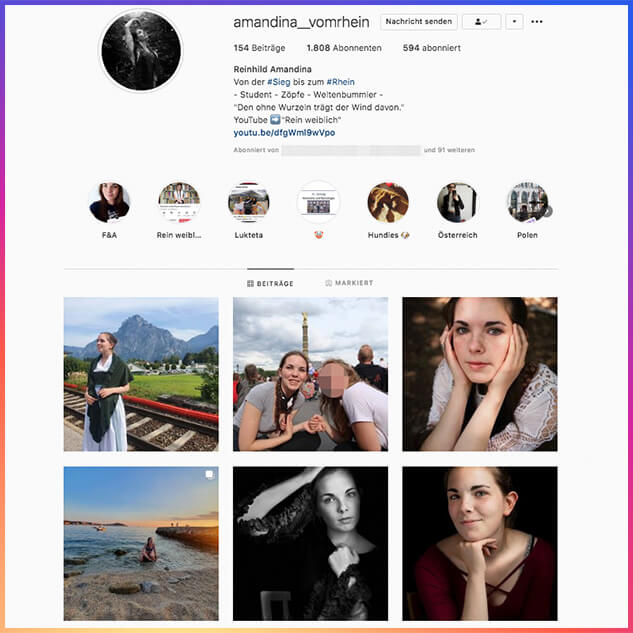
Boßdorf, who is in her early twenties, is currently committed to the AfD. She and several women AfD and JA activists follow each other on Instagram. Among them: Mary Khan, Marie-Thérèse Kaiser, and Lisa Lehmann, all with their private accounts. The JA Berlin account, which Vadim Derksen manages, also follows Boßdorf. When asked about their connection, Derksen said that JA Berlin was not closely familiar with Boßdorf and her past, and that following someone does not mean agreeing with their views. Lehmann, Kaiser and Khan did not respond to requests for comment.
In September, Boßdorf ran for office in the Königswinter local election as a member of the AfD. This was confirmed by the NRW electoral office. Her mother, Irmhild Boßdorf, also ran for office in Königswinter, but in a different constituency. Irmhild is also a member of the AfD Rhein-Sieg district board and runs the local office for Bundestag member Rüdiger Lucassen.
According to the AfD’s incompatibility list, members of the Identitarian Movement are not allowed to join the party. The AfD Rhein-Sieg district did not respond to a request for comment about the matter. When asked whether she is currently a member of both IB and the AfD, Reinhild Boßdorf also did not respond to a request for comment.
CORRECTIV is donation-based
With your contribution, you support independent, long-term investigative stories like this.
Lisa H. describes the Boßdorf family as “völkisch” (thinking of a people in a eugenic sense). In recent years, Reinhild Boßdorf has attended IB events and was significantly involved in the “120db” initiative, in which women wanted to draw attention to an alleged increase in sexual violence committed by migrants. Lisa H. said that she was also involved. Boßdorf also founded the “Lukreta” initiative, which “stands up for women’s rights and against the displacement of women from public spaces”.
“Afraid of Going into the Street”
According to Lisa H., although Boßdorf was “cast out” by the IB community, she continued to orbit their circle. On her YouTube channel, which which was created just five months ago, Boßdorf discusses “women’s political topics”.
In one video, she denounces “modern feminism”. It “comes down to the fact that women are becoming more masculine, and men, more feminine,” she says. Boßdorf believes that femininity belongs to biologically female people, who must also behave and dress in a feminine manner. In her videos, Boßdorf argues that feminism pits women against men, and only addresses sexual crimes when the perpetrators are white. She said that as a woman in North Rhine-Westphalia, she was afraid of going out into the street.
It was through these videos that she eventually gained favor with the IB community. And in the summer, she was interviewed by Martin Sellner, the head of IB Austria.
Fear of violence committed by migrants is a central mobilizing element for women in the far-right network. Lisa H. told us: “I think when I was in contact with them, I used to cry at night for weeks on end, because I was scared my daughters would be raped or Sharia law be imposed, as absurd as that sounds.”
From “Mom Blogger” to Nazi Uniforms
“If you look at the profiles, especially those belonging to women, they look like – how should I put it – Swedish profiles. You see a cornfield, you see a woman in a dress, and you see one baking,” said Lisa H.
Our analysis of a select 50 Instagram accounts from the Far-Right network found an all too common aesthetic: photos of women in traditional clothing, with long, braided hair, in a natural environment, some with references to Nordic mythology.
Of course, not all influencers in network look like this. The number of right-wing women who take on a different aesthetic and discuss topics that “seem quite feminist” is increasing, said Degen, the doctoral student at the University of Bamberg. She said that this makes the far-right even more interesting for young women. Nevertheless, the more traditional, maternal images of women in nature remain widespread in the right-wing scene today.
A good example of this is the account of a “mom blogger” in our dataset. The young mother writes about femininity and allows her roughly 1,000 followers to take part in her family life. In her posts, she wears long dresses, poses in flower meadows, and writes captions that emphasize the advantages of a natural lifestyle, as well as being a housewife and mother.

In one caption, she wrote: “Many women go to work even though they have children. It may be for economic reasons or due to social pressure, since everyone in their social circle does it.” But when work only stresses you out, it drains a woman’s energy. “Then this energy is missing at home, the children don’t get it.” In another post, she described the “essential qualities” of a woman: conception, conservation and devotion.
These views do not necessarily indicate an affiliation with the far-right or right-extremist scene. But the data show that the young woman’s Instagram account is followed by several IB activists. Furthermore, her feed is filled with content from ideologically similar creators. For example, she follows one popular Instagram account called “Heimatverbunden” (Connected to the Homeland), which has over 12,800 followers.
In its profile description, the account includes a rune that originates from the “Lebensborn” association – a state-sanctioned Nazi organization that promoted eugenic ideology under Hitler. Historical photos of people in Wehrmacht uniforms or images with slogans such as “It’s okay to be white” are also posted on the page.
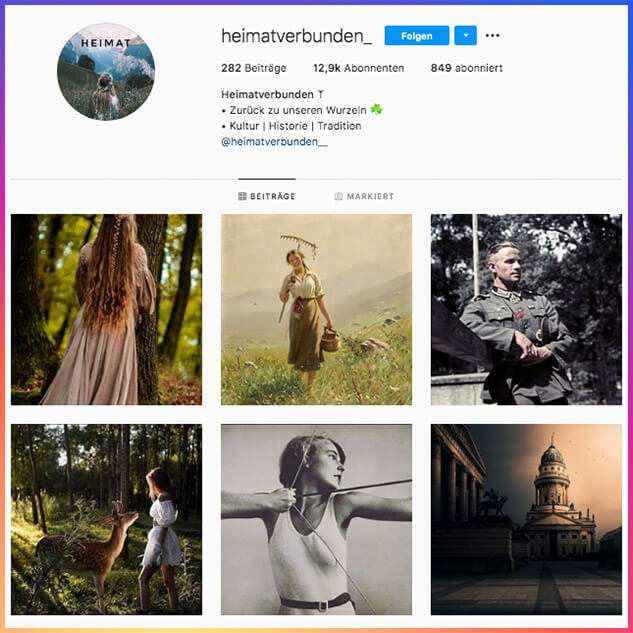
The blogger did not respond to a request for comment. Instead, she switched her previously public profile to private.
The example of the “mom blogger” shows how the lines between right-wing extremism and seemingly harmless content are blurred. It shows how right-wing extremist attitudes play in the background of flaunted aesthetic. So to better understand that how these paths interconnect, we looked deeper into the data.
The young mother follows accounts like “European People”, which has more than 8,900 followers. Some of their photos show the far-right extremist Frank Kraemer, who plays in the far-right rock band “Stahlgewitter” (Steel Storm). Incidentally, Kraemer also follows the young blogger on Instagram, as well as Reinhild Boßdorf. Kraemer told CORRECTIV that he did not know them personally, and that he followed them for “their interesting content.”
Kraemer has connections to the nationalist group Europa Terra Nostra. The initiative, which published a book by the Rockstar, has a member of the far-right National Democratic Party on its board. And like JA and IB, Europa Terra Nostra recognizes the importance of digital media – and offered Photoshop seminars as early as 2018.
An English-speaking profile called “Madame Europa” appeared in our network. Its content focuses on topics like traditional family and femininity, as well as rejecting of feminism. The driving force behind the account is the right-wing extremist group Europa Invicta. In an interview for Kraemer’s blog, Madame Europa’s account manager – a graphic designer from France – said that he wants to portray the aesthetic of Europe as the “home of whites”. The “Madame Europa” account is explicitly aimed at women, with slogans such as “Femininity not Feminism”.

As we delved deeper, undercover, into the world of the Far-Right, we wondered whether the technology itself allowed this network to flourish. So we talked with a researcher who studies social media algorithms, as well as a former Instagram employee.
Expert Opinion: The Right Exploits the Platform’s Weaknesses
Carolina Are is a doctoral candidate at the University of London. She researches, among other things, algorithmic bias: errors in a computer system that lead to skewed results – such as favoring one group of users over another.
“There isn’t that much research about filter bubbles or echo chambers on Instagram,” said Are. “For now, it has focused on Facebook and Twitter.”
However, there are indications that so-called filter bubbles, or echo chambers, can also form on Instagram. The result is that users gradually see more and more content that matches their personal viewpoints, including politics. This phenomenon particularly affects Facebook users. When people are in a filter bubble, they don’t change their mind – but instead, become more polarized, Are said.
“One of Instagram’s main characteristics is the algorithm’s recommendations,” said Are. “If you start liking something a lot, they will send you to something similar.”
We experienced this on our fictional account. When we viewed the stories of people we followed, we got suggestions to look at other, similar accounts.
In our case, that meant right-wing meme pages, right-wing influencers, right-wing clothing brands, and AfD politicians.

Are, however, is not only worried about filter bubble effect. She fears that right-wing extremists could also exploit algorithmic weaknesses.
“At the moment, hate speech isn’t regulated as well,” Are said. Although Instagram effectively filters nudity from user feeds, it is much more difficult for the platform when it comes to hate speech and prohibited symbols. Mark Zuckerberg, head of the Facebook group, said this himself in a 2018 post.
Over the course of our investigation, we saw several unpixellated swastikas and presumably hateful content in images that were altered using simple methods in such a way that the algorithm evidently did not recognize them. For instance, the word “white” appeared, pixelated, in the slogan “It’s great to be white”, so that the image would not be deleted.
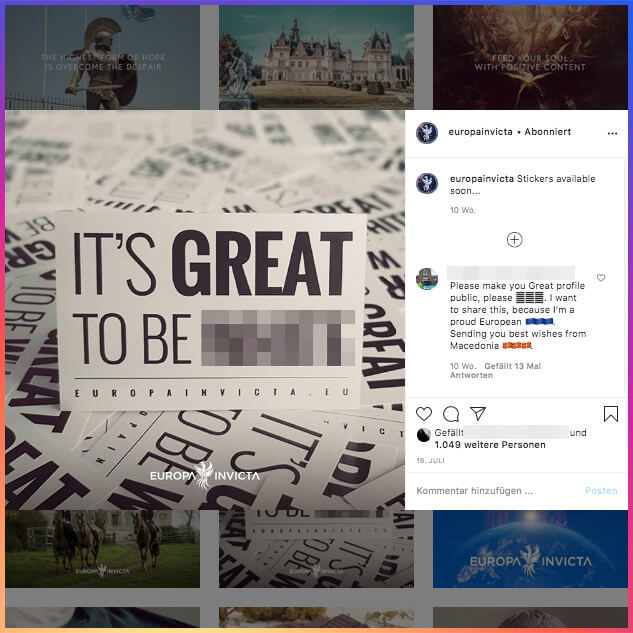
Former Instagram Developer: The Platform Is Not Concerned With How to Recognize German Right-Wing Extremist Symbols
Gregor Hochmuth is convinced that there is a simple explanation: “I can guarantee you that no one at Facebook, at least not for any depth of substance, has looked at how to detect and combat Far-Right German accounts and symbols.” Hochmuth is one of the founding developers of Instagram. He left the platform in 2014 along with many other employees, two years after it was taken over by Facebook. Today, he works as a freelance developer and says that he no longer uses social media. We talked with him over video chat in mid-September.
“I don’t think it’s malevolent. I don’t think they would want this on their platform if they had a choice,” said Hochmuth. “But how do you know if your platform of two billion people has problematic content? You don’t. You look for the stuff you already know exists, but everything else… You don’t know.”
This causes difficulties.
If nature photos, for example, are used as a vehicle for racist hate speech, it is difficult to recognize when no one has previously defined the issue: “It does require. It’s not automatic. A human actually has to sit down with a computer and be like: This is a symbol that’s problematic.” Hochmuth is certain that for German right-wing extremist symbols, this has not yet happened.
According to the developer, after Facebook took over, a large portion of Instagram was redesigned so that the platform resembled Facebook: “It’s a given that the Instagram algorithm, at its core, is the same as the Facebook algorithm. And what we know about the Facebook algorithm is that it creates filter bubbles. It learns about you and what you like.”
After Our Report, Instagram Deleted the Photo of the Sleeping Baby with the Sunwheel
We confronted Instagram with our investigation a week before this text was published. Among other things, we asked them how many German right-wing extremist accounts are being watched by the platform, and what symbols are prohibited.
Instagram informs us that there are “clear rules” in its community standards for “Dangerous Individuals and Organizations” on Facebook and Instagram. Thus, all “content that expresses support or praise for groups, leaders, or individuals involved in these activities” will be removed from the platform. This also applies to symbols and slogans that are used “in a neo-Nazi context”.
A team of 350 people worldwide – including German-language speakers – are concerned with keeping “extremist people, groups or content” away from Instagram. They investigate new trends in language and symbols and know that relevant accounts “sometimes disguise” their activities.
Instagram’s solution makes it look as if the problem under control. But the actual effectiveness of these safety precautions is demonstrated by the picture of the baby with the Black Sun: Instagram only removed the content after someone else had reported it. By then, it had been online for 11 months.
A spokeswoman also said that “the hashtags #DefendEuropa and #heimatverliebt would be investigated,” but only after they were reported by CORRECTIV. She said it would also be “helpful” if we could report other accounts.
Filtering out far-right content should look different.
Well Disguised Hatred
The various right-wing communities mix and overlap on Instagram. They use similar hashtags and can easily disguise their political content. Users can stumble across right-wing extremist profiles without even realizing it.
This is how Instagram can contribute to radicalization.
The Bundesamt für Verfassungsschutz (Domestic Intelligence Service of Germany) confirmed our findings. On platforms with an audiovisual focus, information density is particularly high compared to other platforms, said a representative from the agency. It is therefore a particular challenge for the operators to check the content in full. “In this respect, there is a risk that right-wing extremist ideas can be targeted at young people, while bypassing platform administration and community guidelines.”
An example: A young woman named Josephine, who follows Boßdorf and other accounts in the network, recently posted a picture of “Madame Europa” on her story. It shows a young woman with plaited hair in front of a forest of pink flowers. In a typical Instagram pose, she seems to be pulling the person behind the camera by the hand. “Come on, I’ll show you my world”, is what the picture expresses. It’s caption: “When you’re white, there is no upgrade, don’t mix”.
It seems to be clear to the creators that they are violating Instagram’s rules. When you search for posts about “Madame Europa”, the image shows up blurred and with a note: “This picture may be censored and cause this account to be suspended. Discover it on Telegram.” Then there is a link to a Telegram channel, we found the unblurred photo of the woman with the pink flowers.
People who post about “Europa Invicta” use the same strategy. One unrecognizable picture on Instagram led to a Telegram channel. There, we found the original image: A father with three children in a field of flowers. It’s an idyllic family photo except for one thing – everyone but the little girl is holding a firearm. The caption reads “Verteidige dein Land” (Defend your country).

Our investigation shows that the depths of Instagram are riddled with hatred. But it is a kind of hate that knows how to camouflage itself well. The platform does not seem to have found a way to effectively counteract this dangerous content. Our research took us deep below the surface. But we have not reached the bottom yet.
Make visible where our
democracy is in danger.
CORRECTIV is donation-based. Support investigations like this, to bring right-wing networks to light. Hate and smear campaigns should not remain a secret.
Published on October 19, 2020
Research & Texts: Alice Echtermann, Arne Steinberg, Celsa Diaz, Clemens Kommerell, Till Eckert
Data Science: Celsa Diaz, Clemens Kommerell
Editorial Team: Olaya Argüeso, Justus von Daniels
Design: Benjamin Schubert, Belén Ríos Falcón
Project Management: Marius Wolf
Collaboration: Frederik Richter, Jonathan Sachse, Miriam Lenz, Carol Schaeffer, Melina Hemmer
Communication: Katharina Späth, Luise Lange, Bao-My Nguyen, Valentin Zick
Translation: Max Donheiser
